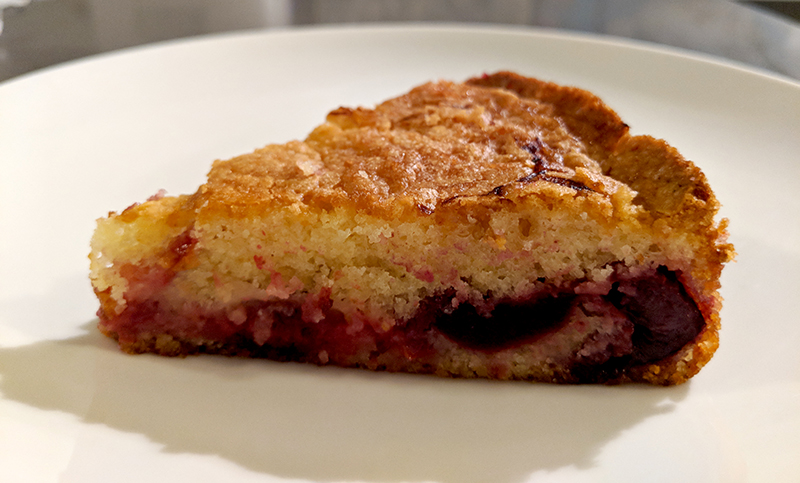Alice’s plum cake

This is a recipe that I got from a friend, who in turn found it in a diary left behind in a Zipcar. Apparently it’s a recipe that has been featured in the NYT, but I am too lazy to go and find it, so if you are curious, know that it’s out there. I made the cake because I had a number of plums that stubbornly refused to ripen, despite sitting out on my kitchen table in the sun, and they were starting to wrinkle from age. I also had a handful of cherries leftover from making the Food52 cherry bundt cake (more on that at a later date).
This is a lovely cake with a light crumb (from all of that baking powder!). I took the liberty of adding some dark rum, as the original recipe didn’t have any flavorings, and I always use dark rum in the place of vanilla extract. (Vanilla beans are another story, and you have to use a decent dark rum — I use Bacardi 8-year reserve.) It’s great served plain, as the high amount of sugar relative to the flour does make for a cake with a slightly crackly top, the way that brownies get when they have a lot of eggs and sugar in them. I imagine that it would also be excellent with whipped cream or ice cream.
Alice’s Plum Cake
Ingredients
198g (1c) sugar (see note)
113g (1 stick) butter, softened
2 eggs
1T dark rum
1T baking powder
1/4t salt
120g (1c) flour
453g (1 lb) stone fruit, pitted and cut into wedges (see note)
2t lemon juice
Directions
1. Preheat the oven to 350F. Toss the plums in the lemon juice in a small bowl and let sit while you prepare the batter.
2. Cream the sugar and butter for five minutes on medium speed. Add the eggs one at a time and mix until well incorporated, scraping down the bowl between eggs. Add the baking powder and salt, and beat until well incorporated, about a minute (start up the mixer on the lowest setting away from the baking powder so it doesn’t rise up in a cloud out of the bowl).
3. Add the flour and mix until a few streaks of flour remain. Use a spatula to scrape down the bowl and mix in the remaining streaks by hand, scraping the bottom of the bowl to make sure there’s no rogue flour hiding under the batter. If there is liquid in the bottom of your bowl of macerated stone fruit, you can fold in a few tablespoons to the batter, or you can use it in a fruit compote or yogurt. You don’t want to just dump it on top of the batter with the fruit because it will make the cake too wet.
4. Butter a 9″ cake pan and line it with parchment paper. Scrape the batter into the pan and scatter the macerated fruit over the top (no need to press it in — the batter will rise around the fruit and it will sink to the bottom). Bake for 50-60 minutes, until the top is golden brown and a tester comes out clean.
[Serves 6-8]
Notes
You can use any fruit you like — just nothing too juicy, like very ripe peaches. I used plums and a few were very ripe, which turned out fine. I had some cherries leftover from making a cake, so I threw those in too. The fruit will vary in size, but generally you want the wedges to be a bite or two. Also, the exact amount of fruit is somewhat variable; I measured out my fruit after I pitted the plums and it came out a couple of ounces over a pound, which turned out fine.
I was concerned about the amount of sugar relative to the flour, so I used a scant cup of sugar — probably a cup minus two tablespoons. It came out nicely, especially with a few of the plums being a bit more tart than usual. The original recipe called for sprinkling the top of the cake with a couple more tablespoons of sugar, but I didn’t think that was necessary.
It’s fine if the batter sits out at room temp for a while before you bake it; my oven only fits one 9″ cake pan and I had made a double batch of batter, so I baked them one after the other and it was fine. I don’t think the parchment paper is absolutely necessary, but since the fruit does mostly sink to the bottom of the cake (with a thin layer of cake just keeping the fruit inside), I recommend it.
I find that my scale isn’t quite sensitive enough to register a single gram accurately, so I typically do baking powder/soda, salt, and spices by volume with measuring spoons, rather than by weight.